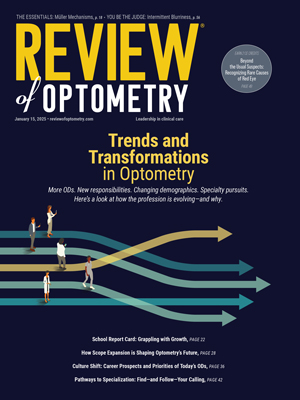|
Convergence problems are common following TBI. This patient is performing oculomotor retraining exercises. Photo: Christopher L. Suhr, OD. Click image to enlarge. |
Although the majority of traumatic brain injuries that occur every year are classified as mild, these cases can still present troublesome symptoms for patients. Those with mild traumatic brain injury (mTBI) often report visual problems, even when fundus exams and visual acuity are deemed normal.
Consequently, researchers recently published a paper in JAMA Ophthalmology reviewing a battery of assessments and machine-learning approaches to aid in diagnosing visual dysfunction in these patients. The prospective investigation included 56 total individuals who had recorded visual acuity and normal fundus exams; exclusion criteria included a history of ocular, neurological or psychiatric disease, moderate-to-severe TBI, recent TBI, metal implants, age younger than 18 years and pregnancy. There were two groups, with 28 participants in each: one reflecting history of mild TBI (mean age 35; 53.6% male) and a control group with no TBI history (mean age 31; 67.9% female), with both groups being sex- and age-matched. The single session included the Neurobehavioral Symptom Inventory (NSI) and measurements of oculomotor function, OCT, contrast sensitivity, visual evoked potentials, visual field testing and MRI.
After performing these tests, it was found that those with mTBI had reduced prism convergence test breakpoint (-8.38) and recovery point (-8.44), decreased contrast sensitivity (-0.07) and increased visual evoked potential binocular summation index (0.32). A smaller subset of patients showed reduced peripapillary retinal nerve fiber layer thickness, increased optic nerve/sheath size and brain cortical volumes. The researchers also employed machine learning models, which identified subtle differences across the primary visual pathway—including the optic radiations and occipital lobe regions—independent of visual symptoms.
The authors note that the most significant oculomotor differences were in the prism convergence test—which included both the break point and recovery point—and reflects previous studies. However, not all those with mild TBI who reported visual dysfunction were captured in differences of this test, and conversely, some who did not report any visual dysfunction on the NSI had measures outside of normal limits. As the authors explain in their paper, this discrepancy could be due to distraction by other distressing symptoms or long-term adaptation to visual disturbances. They further link this finding to potential real-world settings, stating, “The detection of significant differences in prism convergence test (break point and recovery point), with values outside the normative range, suggested that these orthoptic deficits have long-term clinical implications, potentially affecting tasks like reading and concentration.”1
Contrast sensitivity was another test in which significant differences were observed for both monocular and binocular conditions. This is in support of a hypothesis of a previous study that believed contrast sensitivity testing is a crucial indicator of visual dysfunction specifically in mTBI. The authors do mention, however, that “although contrast sensitivity and visual evoked potential results showed statistical differences, they remained within normative limits and are unlikely to reflect functional visual impairments.”1
In an invited commentary also published by JAMA Ophthalmology, the commentary’s authors stress the important implications of the exclusion criteria of the original study. Those with either neurological or psychiatric diseases were excluded; however, disorders of posttraumatic stress disorder, attention-deficit/hyperactivity disorder and anxiety are all known to contribute to visual disturbances, light sensitivity and hypersensitivity, thus not reflective of all real-world scenarios. As the commentators elaborate, “an important area for future work will be the inclusion of groups with coexisting psychiatric conditions and diseases to generate a clearer understanding of potential interactions between mTBI-related visual disturbances and other conditions, given that psychiatric and behavioral comorbidities commonly occur with mTBI.”2
They also reflect upon the fact that “the differences in various regions of cortical volumes observed in participants with history of mTBI compared with control participants highlight the heterogeneous nature of mTBI and emphasize that no single study can fully capture all the ways mTBI may affect vision.”2
| Click here for journal source. |
1. Rasdall MA, Cho C, Stahl AN, et al. Primary visual pathway changes in individuals with chronic mild traumatic brain injury. JAMA Ophthalmol. November 27, 2024. [Epub ahead of print]. 2. Nowak MK, Fortenbaugh FC, Salat DH. Visual deficits in patients with mild traumatic brain injury. JAMA Ophthalmol. November 27, 2024. [Epub ahead of print]. |


